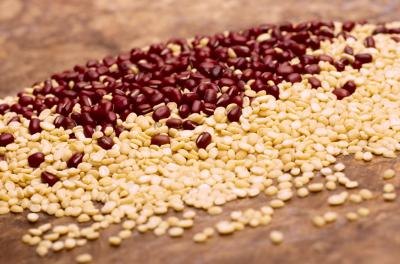
Including protein-rich vegetables in every meal allows you to obtain essential amino acids, compounds that influence muscle development. Amino acids are referred to as the building blocks of protein. Complete proteins such as those found in eggs, milk and meats contain all the nearly 20 essential amino acids. In the vegetable world, only soy beans have complete protein, but peanuts, beans and peas, when combined, provide the full range of amino acids, plus beneficial antioxidants that enhance muscle-cell protection.
A common misconception is that food builds muscle. It does not. Exertion builds muscle. Food provides components that allow muscle-fiber construction, so food certainly enables muscle building. But muscle fibers grow in size and number only in response to a series of chemical reactions initiated by exercise, according to Space Research. Exercise breaks down muscle, setting off intricate chemical interplay involving amino acids. That process begins with protein synthesis at the cellular level, and ends with new muscle fiber construction upon existing muscle.
Protein Requirements and Vegetable Sources
The American Dietetic Association recommends 0.55 to 0.8 g protein per pound of body weight for adults who exercise moderately, and 0.7 to 0.9 g for those who exercise strenuously. For a 130 lb. person, this computes to 71 g minimum and 117 g maximum, levels that are attainable with protein-rich beans and legumes. Top food choices, measured as grams of protein per 1/2 boiled cup, include soybeans, with 14 g; lentils, 8.9 g; kidney beans, 8.4 g; black beans, 7.5 g; lima beans, 5.1 g; and green peas, 4.12 g. Peanuts, which do not require boiling but can be enjoyed that way, are more often consumed roasted; one quarter-cup contains 9.15 g protein. Peanut butter provides 7.7 g per 2 tbsp. Combining these beans and peanuts creates especially high-quality protein, according to the Veggie Table.
Beans' Antioxidants Protect Muscle
Another bean benefit: antioxidants. Antioxidants protect muscle tissue from excessive free radical activity, also known as oxidative damage. Science Daily reports that dark-hued beans are particularly rich in antioxidants. These beans include black, adzuki, pinto, kidney and anasazi beans. Even soybeans, technically white beans, contain the antioxidant tocepherol, a form of vitamin E that protects cell membranes, according to the USDA.
Other Vegetable Protein Sources
Lesser amounts of protein are provided by vegetables such as broccoli, potatoes and asparagus, with protein content ranging between 1 and 3 g protein per cup of cooked, edible food. So, if you exercise with weights or perform weight-bearing activities such as running, target soybeans, beans, peas and other legumes. Dietary protein should not too difficult to obtain if you choose your veggies wisely.
References
- Space Research: Pumping Iron in Microgravity
- Protein Supplements and Exercise
- The Veggie Table: Vegetarian Protein
- American Dietetic Association/Eat Right: Eat Right for Endurance
- Science Daily: 'Musical Fruit' Rich Source Of Healthy Antioxidants; Black Beans Highest
- USDA Agricultural Research Service: Extreme Weather Boosts Antioxidant Levels in Soybean Seeds
No comments:
Post a Comment